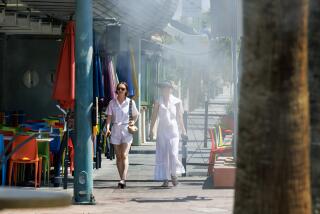California’s 2006 heat wave was much deadlier than previously reported, researchers say
- Share via
As Southern California sweats through a period of triple-digit temperatures that started over the weekend, state researchers said Monday that deaths related to a scorching heat wave in 2006 were probably two to three times higher than estimated by coroner’s reports.
“Everyone knows [the coroner counts] are a low estimate,” said Bart Ostro, lead author of a study published this month and an epidemiologist at the state’s Office of Environmental Health Hazard Assessment. “We’re trying to model it and trying to get a better idea of the impact.”
The researchers analyzed nine counties, including Los Angeles, San Bernardino and Kern. Whereas coroners in those counties connected about 130 deaths to the heat, with diagnoses including hyperthermia and heatstroke, Ostro’s group found that about 350 to 450 deaths were more likely.
Emergency room doctors and public health officials said they have known for years that heat increases mortality and that coroners have been conservative when determining how much of a role heat played in a person’s death.
Even if the current heat wave has been less extreme than the one three years ago, doctors said they hoped the study would result in greater public awareness because similar risks apply now. Officials are investigating whether heat was involved in the deaths of two men who were hiking in the Palm Springs area over the weekend, where temperatures hit 118 degrees.
“People with underlying serious problems -- it could be emphysema, it could be heart disease, and it’s true particularly for older people -- this could be just enough to tip them over,” said Dr. Jonathan Fielding, Los Angeles County director of Public Health.
Meteorologists at the National Weather Service said parts of Los Angeles County reached 110 degrees over the weekend, but they expect the heat to dissipate by the middle of the week.
Public health officials in Los Angeles issued a health alert about high temperatures Monday, encouraging Angelenos to seek out cool locations, check on elderly neighbors and look for symptoms of heat exhaustion such as disorientation and shallow breathing.
Ostro’s study of the 2006 deaths, published in the journal Environmental Research, looked at one of the most extreme heat waves in the state’s recent history. The high temperatures lasted for at least 10 days in many parts of California, and Woodland Hills hit 119, the highest temperature ever recorded in Los Angeles County by the National Weather Service.
Ostro’s group developed new numbers for heat-related deaths by building a model that analyzed data by county and compared the last two weeks of July to the same time window in other years and other parts of the month.
When they analyzed the relationship to temperature, they found that each 10-degree Fahrenheit increase from day to day led to a 9% increase in daily deaths. The heat-related mortality appeared to have the greatest effect on Imperial and Fresno counties, where temperatures were the highest.
Ostro said they believe most of the mortality they calculated can be clearly related to heat, but since ozone and other pollution also increase when the temperature goes up, some of the deaths were probably related to unhealthy ozone levels.
The study did not address the question of what temperature constitutes the threshold for dangerous health effects, but Ostro said his office is working on another study to determine this.
Because several climate models, including the one in the landmark 2007 United Nations report on climate change, have forecast more frequent heat waves with higher temperatures and longer durations, Ostro said the need for better numbers and awareness will be an issue for years to come.
--
More to Read
Sign up for Essential California
The most important California stories and recommendations in your inbox every morning.
You may occasionally receive promotional content from the Los Angeles Times.










